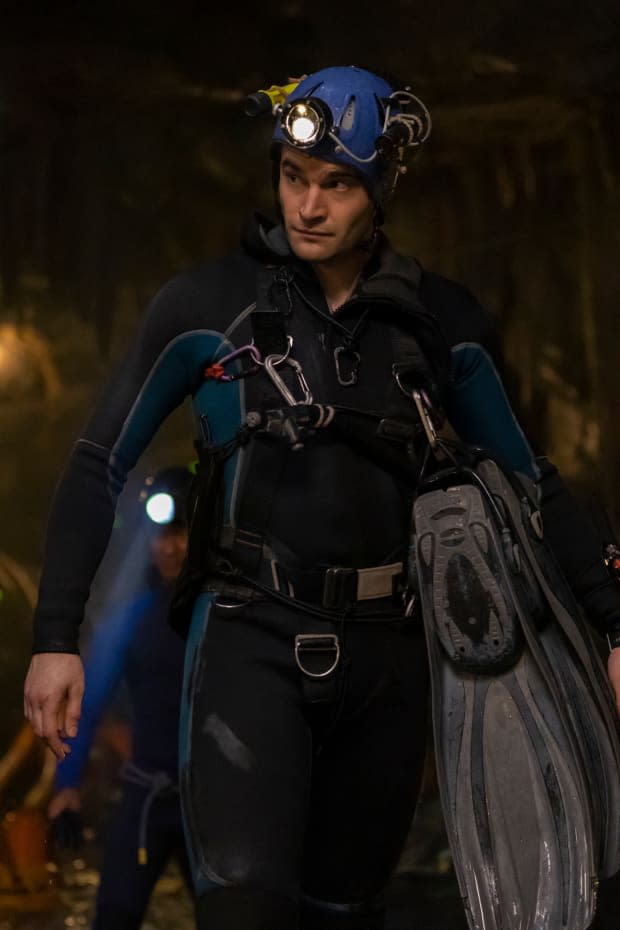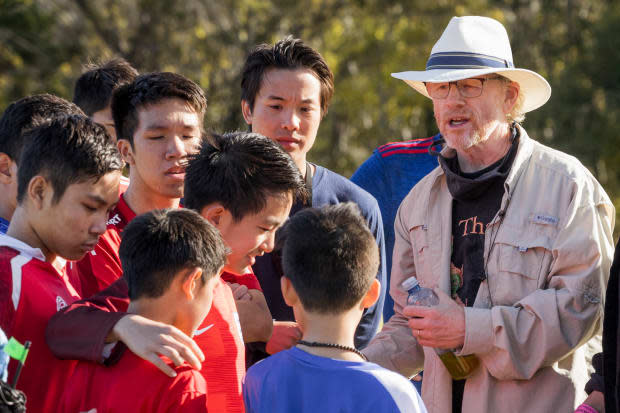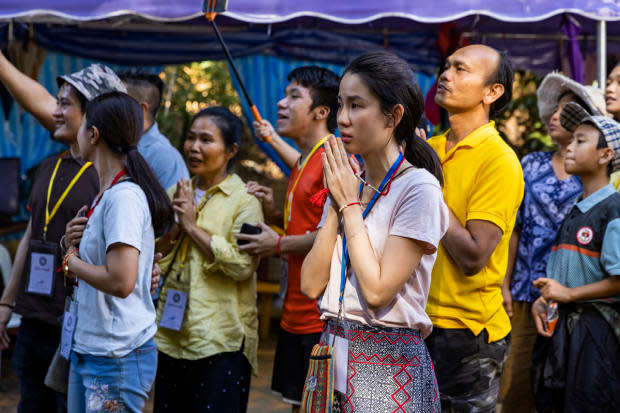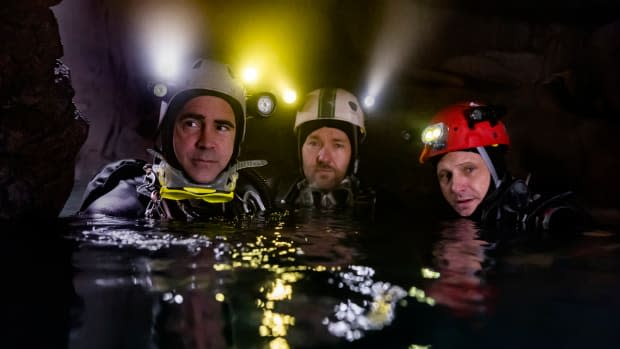Tom Bateman Talks 'Thirteen Lives' and the True Story of the Thailand Cave Rescue Mission
- Oops!Something went wrong.Please try again later.
- Oops!Something went wrong.Please try again later.
With a bit of scuba diving experience under his belt, Tom Bateman said he felt comfortable taking the deep dive for the training involved in making Thirteen Lives, the dramatic new Ron Howard movie based on the story of 12 young soccer players and their 25-year-old coach who were trapped in an underground cave in Thailand during monsoon season.
The heroic 2018 rescue mission—which captured worldwide headlines—brought together divers and other volunteer experts from around the world. It is a story about bravery, heroes, global concern, making the impossible happen and pushing ourselves to our limits for the greater good.
The boys were trapped inside a cave for 17 days with little food and water and were ultimately rescued by some of the best divers in the world played by Bateman, Colin Farrell, Viggo Mortensen and Joel Edgerton.
One extraordinary aspect of this incredible story is that more than 10,000 volunteers from 17 countries worked together to engineer the harrowing rescue of the boys and their coach. With high stakes, against outrageous odds, and the entire world watching, they reveal the limitlessness of the human spirit.
Bateman said the key to the success of Thirteen Lives began with three weeks of training before production began, plus an intense schedule that continued for more than a dozen weeks of filming.
He says he learned to rely on his buddies, in the same way, that the actual divers did, and while maneuvering around the extremely tight tunnels, he said he had to overcome some bouts of claustrophobia.
Related: Celebrities Tweet About the Thai Soccer Team Cave Rescue
“I didn’t really realize how claustrophobic I was, and I learned that on the job. But this is extreme. I think even for people who don’t suffer from claustrophobia going into those tunnels is incredibly difficult,” Bateman exclusively told Parade.com.
“Basically, the fact that only a very small handful of people on this Earth could do what these divers did just goes to show how difficult most people find it,” he continued. “I did suffer from it a lot. It was quite a wonderful thing to work through on the film, to overcome those fears.”
Bateman says that by putting himself in the shoes of a genuine hero, “I found myself becoming braver because I was playing one. I also did a lot of meditation to get through it during the extremely rough patches.”
Read on about why Bateman feels passionate about the messages of Thirteen Lives, what it is like to be directed by the iconic Ron Howard and how he and the other actors bonded from the start of their diving training.
After watching Thirteen Lives I don’t think I want to go in any water for a while.
Tom Bateman: That’s enough, right? Watching that, I think that’s going to be a little like Jaws it’s just going to deter people from the water.
Did you have diving experience before this movie?
I’d done quite a bit of scuba diving, so I have my open water license. But I’d never gone underwater with a ceiling above me, which was quite a different experience. I thought naively it would be a bit the same. I’d gone through big tunnels scuba diving before, but huge ones that you could drive a bus through, so I thought I’ll be absolutely fine. Then as soon as we started the training, I thought, "This is a very different beast!"
Related: Navy SEAL Brent Gleeson Reveals How to Overcome Adversity
How much training did you have?
I sort of say that we were training during the whole film. There was never a point where we went, “Okay, you’re good at diving now, we’ll leave you alone.“ We had about three weeks before we started shooting or just training pretty much every day. Then they started to bring us into the tunnels that we would be shooting in.
I think there were about three different sets that we actually dove into and each time was a totally new experience. We’d have to almost train for a few days before that shoot. In the morning we’d turn up and we’d have an hour before each scene before we started shooting where we could just go through on our own, work out where we might get stuck, where’s a bit tricky, where you have to sort of do something a bit different.

Vince Valituli/MGM Pictures
There was so much drama and tension in the movie that I was on the edge of my seat, even though I know the outcome. Was it highly dramatic filming the scenes?
Yes, it really was. That’s one of the beautiful things about what Ron’s done here. Obviously, with this story, there’s so much material around, so many interviews, so many documentaries, and amazing work done to cover them. I think what Ron has managed to do, and what we all were setting out to do in this story, is just to put the audience right there, like in the cave with these people, with these boys, with the rescuers, with the Navy SEALs. I think the audience could feel that. The fact that you said you were on the edge of your seat, I was too, when I was watching it. I was that all the way through filming it.
It was a constantly high-stakes shoot. There were no really relaxing days on set because that’s what happened during this rescue, there was never any downtime. Talking to the divers, and asking them about their time during the rescue they said it was exhausting. Even when they were trying to grab sleep here and there, they had to prep their kit, they had to plan the routes in and out. They were diving for hours and hours, six or seven hours they were doing the dive. It was exhausting. So, to emulate that, that’s what we kind of went through in our own way.
How long was the film shoot?
It was just over three months. We had to quarantine. It was still during COVID so we were quarantined in Australia for two weeks. Then about two or three weeks of training. I think we shot for about 13 or 14 weeks.
Related: Ron Howard on Mars, Space Exploration and His Favorite Beatle

Vince Valituli/MGM Pictures
What kind of director is Ron Howard? Is there anything that would surprise people who have admired his work for so long?
I think Ron is quite honestly the best kind of director, certainly for this. I think he’s got such a rare talent for being able to present huge spectacles, dramatic cinematic, and engaging stories. But what’s so unique about his work is he can balance that perfectly with an almost, I suppose, independent cinema energy of I’m going to really understand the human beings behind this.
I think something that would surprise people is just how playful the guy is. I kind of thought, "You can’t be Ron Howard and kind of enjoy yourself all the time," but that’s who he is. He was kind of like a kid running around wanting to just share everything with everyone. He was never tired or grumpy, he was constantly inventing and playing and finding time to just come and sit with us and tell us anecdotes and jokes.
Did you think about why these men risked their lives for the trapped boys? What do you think makes people step up like that and put themselves in harm’s way for somebody halfway around the world that they never met?
The amazing thing is I don’t think that ever came up. I think that’s just a testament to the kind of men they are as divers, as well as everyone involved in that rescue. I just learned today from one of the rescue guys, the guy who diverted the water from the top of the mountain, he keeps telling us these little moments that were happening above ground. He said that when he got there to the top of the mountain he just got on Facebook, “Can anyone help us with supplies?” He said it was incredible that everyone from all over just brought sandbags and supplies and pipes and tools and food supplies and water supplies for them.
I don’t think anyone questioned whether we should do this, or if we will do it. It’s interesting in the film to see there are moments where people are resistant to the plan. Joel’s character, Dr. Harris, questions the plan. But once they were actually faced with the fact that this is the only way to get these boys out no one questioned it. No one said, “Actually, I’m a bit scared. Actually, I don’t think I can do this.” They all just did it. They put themselves in harm’s way and that was down to every single technical person there and every diver and every Navy SEAL person. I think that’s what was humbling about it.

Vince Valituli/MGM Pictures
What makes this a remarkable story to make into a movie?
I remember Colin Farrell coming to me very early on. I was in my dressing room having lunch, and he came and he just sort of leaned on the doorway for about 30 seconds without saying anything and then he just said, “I can’t believe these guys just did this.” We were finding it very hard. I think throughout the entire film that constant awe that we had that you actually did this and you didn’t know these boys and you knew that it might fail and you might die. Sam, the Navy SEAL, lost his life trying to get supplies to the boys. After Sam died people could have said, “Is this too dangerous? We can’t do this.”
But they all still got in the water, they all still did it. It’s just a truly inspiring story, and I think it’s exactly what the world needs right now; seeing anyone from wherever you are in the world to save someone you’ve never met before and will probably never see again because it’s the right thing to do and the good thing to do, this is a true story, it actually happened, I think it’s really important for people to remember that.
How was it talking to the real Chris Jewell, the diver you portrayed for this role?
Once I was offered the role very quickly my inbox became full of research material from Ron, documentaries, interviews and press cuttings. Within about two days of my being offered the role, I was on a Zoom with Chris Jewell. All of the divers were so selfless with their time. He gave me about five hours one morning and just sort of talked through everything, who he is, where he comes from, what he was feeling, what he was thinking. It was a real privilege to have that because it was our job to make this as authentic as possible.
It became so much easier because anytime we maybe were a little bit unsure about a moment in the story I could just WhatsApp Chris and say, “Morning. I’m just doing this scene. What did you do that morning?” He’d say, “I remember that morning we were refilling the batteries to our headlamps,” or, “We were sort of checking in on our gear.” It just sort of bedded everything in reality having them there.
Related: Oh, Happy Days! Get to Know Ron Howard's 4 Kids
Did you get any feedback from Chris or the others? Have they seen the movie?
They all saw it. Chris sent me a text when he saw a very rough cut quite a few months ago. But then when we had the premiere in London Chris was there and I got to actually meet him face-to-face. I hadn’t previously met him face-to-face because of COVID restrictions. He was really pleased with it. They were all consulted on this every single step of the way so for them there wasn’t a sort of a surprise in how we were telling the story. They were such a major part of making it. Chris came up to me after we saw the film and said that we got everything right. To have him say what a good job we did meant a lot to me.
What else did you learn about yourself besides that you're a bit claustrophobic?
I learned that we are capable of more than we think. There were moments when I genuinely thought I don’t know if I can do this. Like physically get through that hole. I don’t know if I can do this. But it’s quite amazing if you set your mind to something and you really sort of push the boundaries of what you think you’re capable of and what you can achieve. I remember my last day filming on set it happened to be a stunt day where I was underwater with the guys. I remember the sense of relief that I’d done it, that I didn’t have to go in those tiny caves anymore. But also, a real sense of pride that I’d overcome that. I remember looking back and reflecting on that thinking oh, man, at the beginning of this—you have changed so much. At the beginning of this, you didn’t think you could do this and now you have.

Vince Valituli/MGM Pictures
How did you bond with Colin, Joel and Viggo?
I think that was a result of the training that we all did together. We came out of quarantine the same day and we went straight to the studio and got straight in the water. Although we were training separately, we were all in the same big tank learning how to do things. What was lovely about this film was there was never really a point where we just went back to our trailers and hung out until they were ready for us. So much time was spent getting into the gear and out of the gear that there was no time. We’d kind of just sit in the tanks all day.
We’d have to sort of check in on each other. We had each other’s backs in the tank because once we were under there, your kind of on your own with your guys. So, any trouble we had I remember I’d be swimming behind Joel and his breathing regulator would get caught, so he’d back up and I could sort of pull the tube off and free him up. That happened to me, too. I think Colin helped me out with my fin that got stuck in the rocks. That kind of just over the weeks really builds up to a beautiful brotherhood, I suppose. As I said, there was no ego involved.
Once you got into the pool, we were all in the same boat and we were all just trying to do the best we could and we’d come up after each stunt dive and say, “Oh my God, that bit when that happened, that was amazing. I saw you struggling with that and you got through it. I hope they got that.” It really bonded us. There was never any separation between us.
Thirteen Lives debuts on Amazon Prime Video on Aug. 5.
